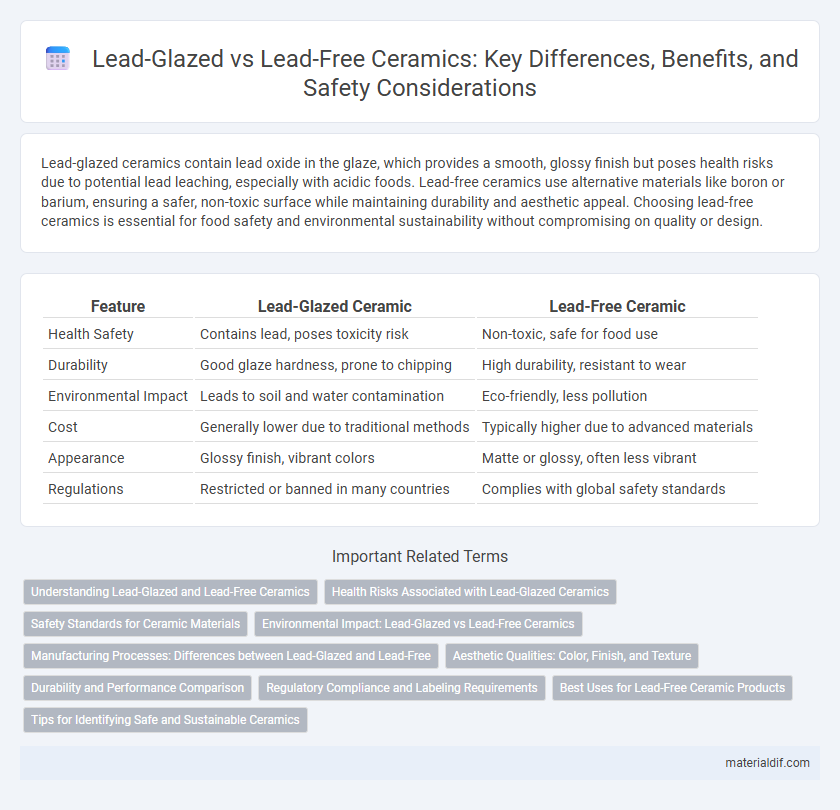Lead-glazed ceramics contain lead oxide in the glaze, which provides a smooth, glossy finish but poses health risks due to potential lead leaching, especially with acidic foods. Lead-free ceramics use alternative materials like boron or barium, ensuring a safer, non-toxic surface while maintaining durability and aesthetic appeal. Choosing lead-free ceramics is essential for food safety and environmental sustainability without compromising on quality or design.
Table of Comparison
| Feature | Lead-Glazed Ceramic | Lead-Free Ceramic |
|---|---|---|
| Health Safety | Contains lead, poses toxicity risk | Non-toxic, safe for food use |
| Durability | Good glaze hardness, prone to chipping | High durability, resistant to wear |
| Environmental Impact | Leads to soil and water contamination | Eco-friendly, less pollution |
| Cost | Generally lower due to traditional methods | Typically higher due to advanced materials |
| Appearance | Glossy finish, vibrant colors | Matte or glossy, often less vibrant |
| Regulations | Restricted or banned in many countries | Complies with global safety standards |
Understanding Lead-Glazed and Lead-Free Ceramics
Lead-glazed ceramics contain lead oxide in the glaze mixture, which provides a smooth, glossy finish and enhances color vibrancy but poses health risks due to potential lead leaching. Lead-free ceramics utilize alternative compounds like boron or barium to achieve similar aesthetic and functional properties while ensuring safety and compliance with regulatory standards such as FDA and EU guidelines. Understanding the differences between lead-glazed and lead-free ceramics is crucial for manufacturers and consumers focusing on durability, safety, and environmental impact.
Health Risks Associated with Lead-Glazed Ceramics
Lead-glazed ceramics pose significant health risks due to the potential leaching of lead into food and beverages, leading to lead poisoning, which can cause neurological damage, developmental delays, and kidney problems. Lead-free ceramics eliminate these hazards by using safer materials such as boron, zinc, or other non-toxic fluxes, ensuring safer consumption and reduced environmental impact. Regulatory agencies worldwide increasingly restrict lead in ceramic glazes to protect public health and promote safer alternatives.
Safety Standards for Ceramic Materials
Lead-free ceramic materials comply with strict safety standards set by regulatory agencies such as the FDA and EU, ensuring no toxic lead leaches into food or drink. Lead-glazed ceramics, while historically common, pose health risks due to potential lead exposure, especially if improperly fired or damaged. Modern manufacturing prioritizes lead-free glazes to meet rigorous safety certifications and protect consumer health.
Environmental Impact: Lead-Glazed vs Lead-Free Ceramics
Lead-glazed ceramics release toxic lead particles during production and disposal, contaminating soil and water, posing significant environmental risks. Lead-free ceramics use non-toxic alternatives, reducing hazardous waste and minimizing ecological damage. Shifting to lead-free glazes supports sustainable manufacturing and protects ecosystems from heavy metal pollution.
Manufacturing Processes: Differences between Lead-Glazed and Lead-Free
Lead-glazed ceramics involve applying a glaze containing lead oxide, which lowers the melting point and produces a glossy, smooth finish during firing at lower temperatures around 900-1100degC. Lead-free ceramics utilize alternative fluxes such as boron or barium compounds, allowing firing temperatures typically between 1200-1400degC to achieve similar surface qualities without hazardous toxins. The manufacturing process for lead-free ceramics demands precise control of kiln atmosphere and raw material composition to ensure durability and non-toxicity, aligning with modern environmental and health standards.
Aesthetic Qualities: Color, Finish, and Texture
Lead-glazed ceramics display vibrant, glossy finishes with deep, rich colors and smooth textures that enhance decorative appeal, while lead-free ceramics often present a more matte or satin finish with subtle, natural hues, reflecting contemporary aesthetic preferences. The absence of lead allows for safer, non-toxic glazes that maintain durability without compromising artistic expression, though sometimes with a slightly less intense color saturation. Surface textures in lead-free ceramics tend to have a more tactile, organic feel, contributing to a modern rustic look compared to the traditionally sleek and polished surfaces of lead-glazed pieces.
Durability and Performance Comparison
Lead-free ceramics offer superior durability due to their resistance to chipping and cracking compared to traditional lead-glazed counterparts. Lead-glazed ceramics tend to have a smoother, more glossy finish but may leach harmful substances over time, impacting long-term performance and safety. Performance in high-temperature environments is enhanced in lead-free ceramics, making them more suitable for modern culinary and industrial applications.
Regulatory Compliance and Labeling Requirements
Lead-glazed ceramics often face strict regulatory compliance due to the toxic risks of lead leaching, requiring clear labeling to inform consumers of potential hazards. Lead-free ceramics meet stringent safety standards set by agencies like the FDA and EU regulations, which mandate precise labeling to certify the absence of harmful substances. Proper compliance and accurate labeling ensure consumer safety and market access, distinguishing lead-free ceramics in health-conscious markets.
Best Uses for Lead-Free Ceramic Products
Lead-free ceramic products are ideal for food storage and cookware due to their non-toxic, safe glaze that prevents lead contamination. These ceramics offer durability and resistance to high temperatures, making them suitable for baking dishes, plates, and mugs used in everyday kitchens. Their eco-friendly composition supports health safety standards and environmental sustainability, ensuring safe contact with all types of food and beverages.
Tips for Identifying Safe and Sustainable Ceramics
Lead-free ceramics use safer glazes made from non-toxic materials, significantly reducing health risks compared to traditional lead-glazed pottery. Look for certifications such as FDA approval or statements indicating compliance with European Union safety standards to ensure the ceramic is free from harmful lead content. Visual inspection for smooth, intact surfaces without discoloration or chipping helps identify durable, sustainable ceramics that maintain food safety over time.
Lead-glazed vs Lead-free Ceramic Infographic

 materialdif.com
materialdif.com